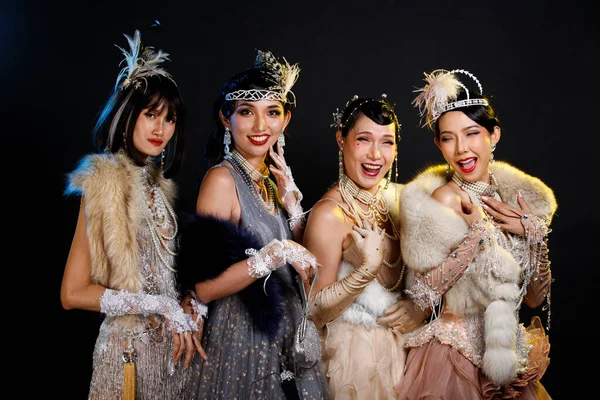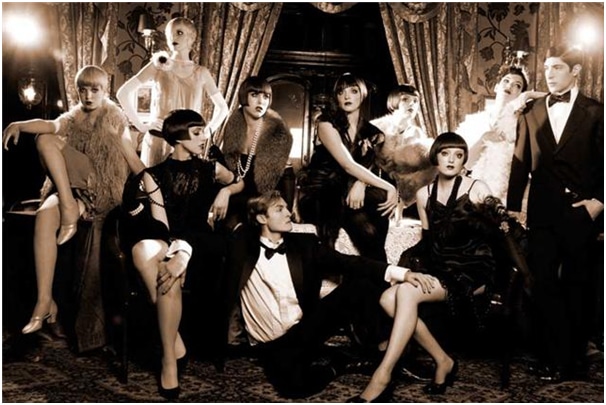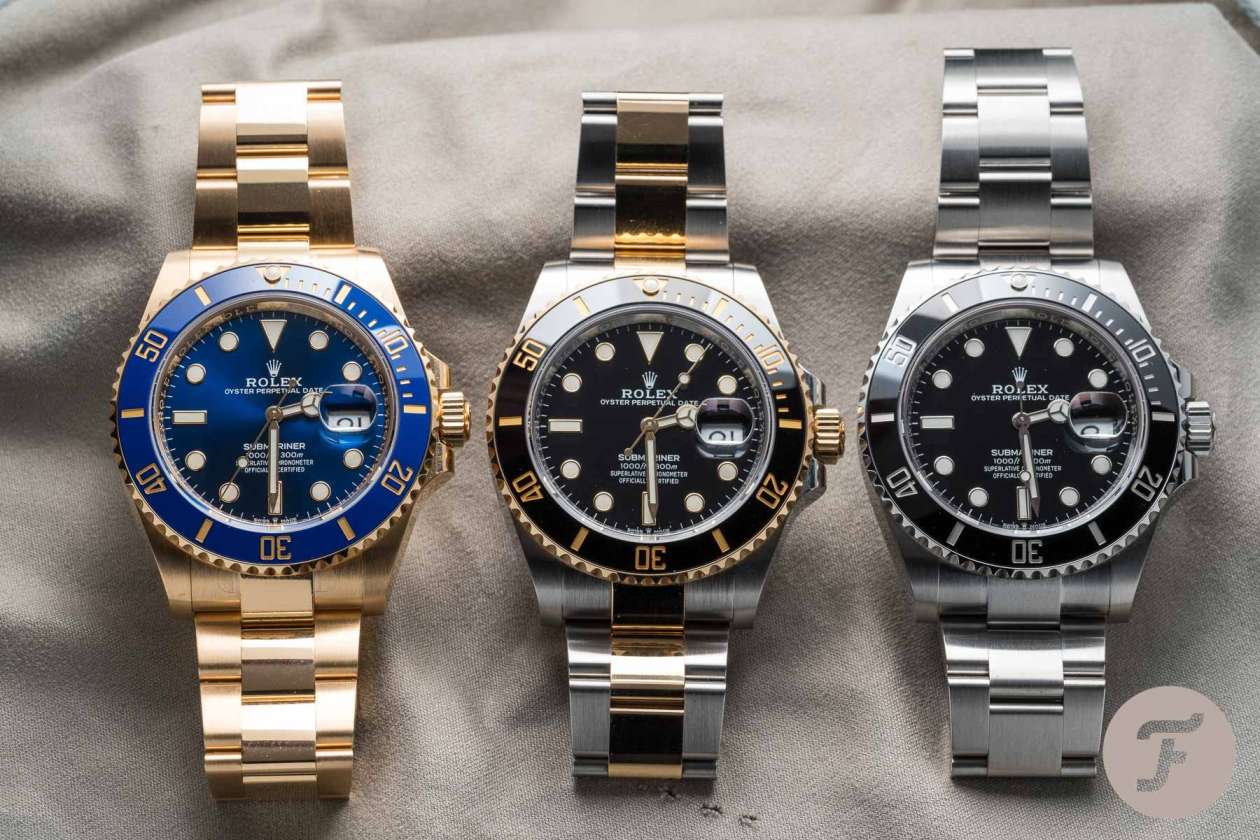Are you ready to travel back in time to the 1920s? For now, you may have to settle for traveling and attending a 1920s-themed party or special event. One day, we may have the opportunity to travel back in time. Start planning your trip now to be one of the first to board.
I'll tell you what was trending in this email. While you might think that all women's fashion revolves around the flapper dress, that's not the case. Then I will show you what other styles women wore in the 1920s.
I will also share some ideas about famous films from the 1920s, such as Example: Gatsby, the Magnificent . and what they did right and what they did wrong.
At the end of this article you will find detailed tips to help you create 1920s fashion for the theme of your next event.
Let's get started!
Introduction to 1920s fashion
Come and travel to the 1920s in a time machine. Women simply gained the right to vote. Depending on where exactly we end up, Howard Carter may have opened King Tut's tomb in England, or people may be excited about the first Macy's Day parade. Charles Lindbergh just crossed the Atlantic for the first time aboard the Spirit of St. A Time, or Alexander Fleming just invented penicillin. It may take you a while to discover some of these events while you still gather around the radio to listen to the news, as John Logie Baird gave the first public demonstration of television only in 1926.
Get dressed quickly because you don't want to attract attention. Be grateful that you don't have to wear all the layers of decades past. If you don't know what to wear, read on and discover the fashion of the 1920s.
What was the fashion style of the 1920s?

Women gained the right to vote in 1920, but they also voted at home, to free themselves from the formality of the many layers of clothing they wore at home and in public. As the decade progressed, styles became shorter and the fabrics of choice became lighter as well.
Coco Chanel and other designers led the way when women's waistlines began to drop in 1923. At the same time, hemlines began to rise in 1926. Two years after that the waist circumference started to increase again. Simplicity was key to both evening and daywear throughout the decade. Housewives sewed many garments with seamstresses and often spent hours sewing beads, fancy embroidery, and sequins onto dresses for special occasions.
If men began wearing sportswear in the 1870s, women joined them after former tennis players Jane Régny and Jean Patou opened fashion shops. Most designers have created activewear for very specific sports, such as tennis, which has grown enormously in popularity. Chanel introduced sportswear that women could wear for more general occasions.
Of course, people often remember the 1920s when this was the dress flappers. Instead of applying for a dress, the presenters first met a group of women who fought hard for female independence and many of whom loved to party. Coco Chanel, Elsa Schiaparelli, and Jean Patou popularized the men's work shirt dress, but I'll talk more about this style later in the article. They didn't use as much decoration as is often shown. More elaborate flapper-style dresses would not be produced for another 40 years.
There were changes in men's fashion, too. Prohibition officially began on January 17, 1920, so men in jazz clubs wore casual clothes, often with colorful accessories, while attending lavish shows.
Why fashion Was it important in the 1920s?
The 1920s saw a loosening of many social rules while the world was still recovering from the effects of World War I, which ended on December 5, 1918. Things that many considered critical before the First World War World War World War. The war no longer seemed so important. Almost everyone was happy at that time and this was reflected in the clothes they wore.
In the United States it was easy for people to make a living. Its economy grew 42% over the decade. Although many people still made the majority of their wardrobe at home, ready-to-wear became widely available for the first time. With money earned from work, people were willing to spend a lot to show themselves and their loved ones the latest fashion trends.
It became much easier to keep up with the latest fashion trends of the 1920s and people had the disposable income to keep up with these trends. Especially after Sears released its first catalog in 1925, people from all over the world could see and buy the latest trends.
It hadn't even been a decade since when this happened. world peace from “The Rise of Adolf Hitler”. For much of the decade, no one expected the Wall Street Crash of 1929, and people were willing to spend money to look cool.
History of women's fashion in the 1920s
Women in the 1920s refused to hide their bodies under many layers of clothing. Changes are happening rapidly in women's fashion, from the nightgown or sheath dress to the first black cocktail dress. While not initially for everyone, hemlines were raised to expose women's knees.
Initially presented as outerwear on the Parisian catwalks. In 1916, women began wearing hemmed shirt dresses. as everyday clothes and no longer wore them as outerwear. These dresses hung directly from the shoulders. Since the look didn't appeal to everyone, designers introduced the empire waist with high hemlines.
In the mid-1920s, flapper-style dresses were a normal item of men's clothing. Intricate beading inspired by Art Deco designs often covered dresses, and some designers incorporated exotic materials such as ostrich feathers into their designs. These sleeveless dresses often had a bare back but still reached the knees.
In 1926, the first black party dress appeared in the pages of Vogue magazine, where the editors called it the Ford suit, named after the car that was becoming increasingly popular. Coco Chanel designed the black dress for everyday wear, but Chanel soon designed many black evening dresses. The designer described her first dress as a simple design made from modest materials.
An important fashion accessory for women in the 1920s was the hat bell, with which women wore almost all their clothes. Manufacturers paid milliners to make these bell-shaped felt hats that would match their ready-to-wear outfits perfectly. Women wore ribbons of specific colors or ribbons with designs on them to send a message to all who saw them. One fashion choice was a ribbon with an arrow to indicate that a young woman was in a serious relationship.
I hope you're starting to get an idea what we should take with us in the time machine when we return to the 2020s. However, don't worry if you still have questions. In the next chapter I'll help you expand your knowledge of what men wore in the 1920s, then I'll take a closer look at what women wore.
Women's Fashion of the Roaring '20sThe last section was about men's fashion of the '20s. Every man liked to have a well-dressed woman on his arm, so let's take a look at women's clothing from the 1920s.
I already talked about the flapper . dress, but in this chapter I will cover more details and other notable options that women wore in the 1920s.
What did women wear in the 1920s?

After World War I, women were encouraged to gain the right to vote and have husbands at home. They gained strong independence in the 1920s. It was a decade in which most families had an easy livelihood.
In the following decade, many women stopped using the clothes they wore. sewn at home. Instead, they flipped through the pages of mail-order catalogs to decide for themselves which sets to order.
Because most families owned a car, traveling became a problem. So women had to do their best. Many were regulars at jazz clubs locally and around the country and wanted to be the best dressed women at these events.
Women's Dresses of the Roaring '20s

By the 1920s, women no longer hid their bodies under layers of clothing. While you might immediately think of flapper style dresses, they were just one style of clothing that women wore in the 1920s.
Almost all women wore a sweater dress . Homemade. Cotton, although there were some varieties of clothing with blends of wool and linen. Women avoided all woolen clothing because it retained odors. Vichy was a common choice. Outside the home, women rarely wore everyday clothes, but they wore them almost every day when preparing food, dusting, and doing household chores. There were several styles, but most were tied at the waist with a cloth belt. As the decade progressed, styles became more elaborate.
After completing household chores, women wore a day dress to go to work or shopping . Various materials were used to make these dresses, including jersey, wool and linen. Most were made in muted colors, especially in winter, while summer colors were generally brighter. Women wanted to be tall and thin, so horizontal lines with decorative embellishments were often created to make them appear taller and thinner. Many day dresses had bateau necklines or crew necks. Other dresses had long V-necks with bows at the hem. Most day dresses had long sleeves, as only wealthy women with beautiful arms wore short-sleeved designs.
Rich women often wore tea dresses the evening. bringing them. a white dress. Although slightly poorer women wore dresses for afternoon tea, they tended to wear pastel colors due to the difficulty of keeping a white dress clean. Manufacturers offered various options for dresses made of cotton muslin, organza, silk, linen, or women sewed them themselves. Most of the dresses had elaborate embroidery.
Women's evening dress of the Roaring Twenties

Every wealthy woman had at least one sequined evening dress in her closet. Countless sequins with intricate floral designs were hand-sewn onto these long dresses using gold or silver threads.
Women celebrated a new sense of freedom by combining nude dresses with shorter dresses. the ones on the sleeves had hems. for dance and jazz venues. These dresses often had a high neckline, and tailors made intricate cuts across the back to expose the woman's bare skin. Women typically wore these dresses with apricot or pastel peach colored tights.
While women with slim bodies often wore flapper-style dresses, women more commonly seen they wear flapper style clothes. clothes. . These dresses had a blouse that hugged the woman's body and a full skirt. Usually made of velvet, organza, satin, or silk taffeta, the waist of these dresses reached about halfway down the hips. Most of the options were sleeveless. After about 1923, women adopted fewer gown-style dresses for daytime parties, reserving their best option for evening dresses.
Worn until the end of decade. some evening dresses returned to using short sleeves. Many of these dresses had a high hem that ended in the front, around the woman's knees. The hem of these dresses reached mid-calf in the back. This began a trend that lasted until the 1930s, when hemlines slowly began to drop.
Women's Sportswear of the Roaring '20s

Women wore a variety of women's athletic clothing. sportswear in the 1920s. Pants were a popular choice for female golfers. At the beginning of the decade, women wore gray or beige culottes made of denim, tweed, linen, or twill. The panties are gathered low, below the woman's knee. Most options had cut-out crotch pockets, which were more aesthetic than practical, and most options had buttons on the sides. In some communities these pants were completely banned, while in others their use was limited to the golf course. By the end of the decade, women also opted for corduroy trousers.
Some women also wore breeches or trousers when taking off their saddles and riding horses . For the first time assembled. Time. These trousers fit perfectly from knee to toe and were also very loose and ended at the woman's natural waist.
While women played tennis in dresses of all days in the 1920s. , professional players wore white suits. French tennis player Suzanne Lenglen sparked controversy at Wimbledon when she wore a calf-length skirt during her match in 1921. She wore a sleeveless white top and a flapper-style headband. Sports broadcasters went crazy and Wimbledon had to move to a new venue two years later to accommodate a growing audience.
Skirts for women of the Roaring Twenties

Part of the new freedom women felt in the 1920s allowed them to wear skirts in which they could move freely. By the middle of the decade, many women were no longer wearing skirts.
By the early 1920s, full skirts were a popular choice. These skirts often reached the ankles and were similar to today's pencil skirts, with a little more fullness in the thighs. They were usually made of wool and were dark in colour, with brown being a particularly popular choice.
In 1922, the length of the skirts was shortened and to many options. ends mid-calf. These skirts had a fuller design and a wide waistband. Most had patch pockets. The geometric patterns made them elegant. Women wore a dark skirt in the winter and a lighter version in the summer.
Just two years later, women returned to wearing straight skirts that reached their ankles . These skirts were usually attached to camisole blouses, although some styles were available separately and had a narrow waistband and a side button.
After 1925, women they wore two matching skirts. Two-piece suits with colorful patterns on the top and bottom. Additionally, pinafore skirts worn over a blouse became a popular choice.
Women's Blouses of the 1920s

Fashionable in the late 1920s 1910s In the 1980s, women's blouses were exclusively white, but this was no longer the case by the 1920s. However, most blouses were still tucked into skirts and rose a few inches at the waist to hang above the waist of the skirt.
Although today we can call it a wrap blouse, it was called a jacket and enjoyed great popularity around 1923. These blouses were wrapped around the body and tied at the waist side of the flanks. Women often wear them over day clothes to make them more elegant.
Many women also choose a men's shirt with more feminine details. Fastened at the front with six or eight buttons, these blouses featured ruffles, pointed collars, and modest V-shaped openings. They were often finished with a wide belt with buttons on one side.
Middy shirts were a fashion option. These shirts, inspired by Navy sailors' shirts, usually had a large fabric scarf around the neck. Physical activities such as bowling and horseback riding have been mastered.
Advice on how to dress like the 1920s for women
I have already talked about many women's fashion trends. Now you know that women wore more than just flapper dresses to celebrate their newfound freedom. Luckily, these clothes are fun to wear because the goal of this decade was to create clothes that women could move comfortably in. Many trends that originated in the 1920s are still very popular today, so you can wear them easily and maybe even have some in your current wardrobe. The wide variety of styles makes the decade fun to recreate, even if you can't look back and see the decade in real life.
Think sporty
If you need a 1920s outfit, think of something sporty. Not much has changed when it comes to high top sneakers. You can become a runner by adding elastic to the bottom of your shorts. Wear it with your favorite shirt and a button-down sweater. A riding outfit can easily be put together using riding breeches and a button-down shirt, preferably with a turndown collar. Tennis looks are also easy to recreate, as all you need is a low-cut, sleeveless white dress. Pair the dress with a sun hat and bring along a wooden tennis racket.
Embrace the jewelry
The 1920s it was a decade for art deco costumes. . Jewel. In most cases, the bigger and more colorful it is, the better. Women wore numerous bracelets to draw attention to their arms, which until then they had to keep covered. Gemstone earrings pair perfectly with long necklaces. Consider necklaces that wrap around your neck multiple times or choose to wear multiple necklaces. Wearing large, elegant cocktail rings is a great option. Especially when going out in the evening, most women wore earrings, necklaces, bracelets and rings to attract attention.
Choose brown
Brown was a favorite color of the 1920s. Riding breeches were almost always brown, as were skirts. Brown was also the favorite color for daywear in winter, but not in summer. Most flapper dresses were brown and decorated with natural or nature-inspired elements. The trimmings and decorations of the clothes were mostly brown. Many women's winter wardrobes contained many brown clothing items, including brown shoes, sweaters, and coats. One reason is that brown is less dirty than white or pastel colors, allowing women to spend more time without doing laundry.








